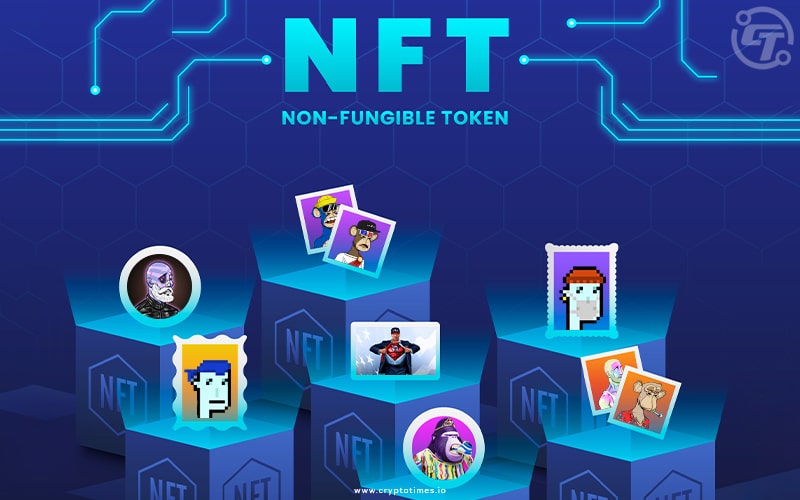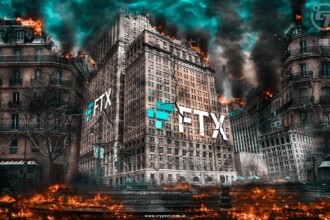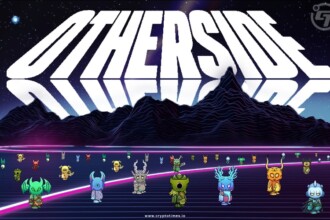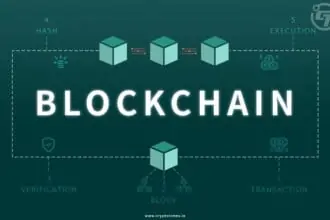Behold, digital adventurers, for a mystical revolution has taken hold of the virtual realm! Prepare to embark on a journey of discovery as we unravel the enigmatic world of NFTs that has bewitched the digital landscape.
NFTs have become the talk of the town, pervading various industries with their enchanting presence. These unique digital assets, spanning everything from art and music to even games and sports, are experiencing a frenzy of buying and selling, with some fetching astonishing sums in the millions of dollars.
In recent developments, the crypto community has been buzzing with excitement over the emergence of Bitcoin NFTs, also known as Ordinals Inscriptions. These unique NFTs are intricately engraved on satoshis, utilizing the power of the Bitcoin blockchain. The overwhelming response to Ordinals Inscriptions led to the introduction of Ethscriptions, expanding the world of blockchain-based collectibles even further.
In a world where pixels hold immense value and virtual treasures captivate hearts, NFTs emerge as the key to unlocking a new era of ownership. But what exactly are these elusive tokens, and how do they weave their enchantment?
What are NFTs?
NFTs, or Non-Fungible Tokens, are a unique digital assets that represents ownership or proof of authenticity for a specific item or piece of content. Unlike cryptocurrencies such as Bitcoin or Ethereum, which are fungible and can be exchanged on a one-to-one basis, NFTs are indivisible and cannot be exchanged on a like-for-like basis.
NFTs can represent various forms of digital or physical assets, including digital art, music, videos, virtual real estate, virtual collectibles, and more.
Imagine possessing a digital masterpiece, a rare collectible, or a unique piece of music that exists solely in the digital realm, with no physical counterpart to be found. This is the essence of an NFT – a Non-Fungible Token. Unlike the interchangeable nature of cryptocurrencies, NFTs possess an otherworldly quality, each one standing as an irreplaceable and indivisible entity.
How does NFT work?
Non-fungible Tokens aka NTFs, are unique digital assets that are stored on a blockchain, a decentralized and transparent ledger. Commonly, the Ethereum blockchain serves as the primary home for NFTs, although other blockchain platforms also offer support for these unique assets.
The genesis of an NFT involves the minting process, where digital representations of both physical and non-physical objects are transformed into valuable tokens. At a broad level, minting includes the creation of a new block, the validation of NFT information by a validator, and the subsequent closure of the block.
Often, smart contracts are employed during this process to assign ownership and regulate the transfer of the NFT. Each Non-Fungible Token has a special code that sets it apart from others, enabling easy ownership verification and transfer between individuals. Even if thousands of NFTs representing the same item are minted (similar to general admission tickets for a movie), each token retains its unique identifier, allowing it to be distinguished from the rest.
These tokens derive their value from the market, just like physical assets, and can be purchased and sold accordingly. What makes NFTs intriguing is that they can represent both digital and real-world items, such as artwork or real estate. By tokenizing tangible assets, some users believe that the process becomes more streamlined, making buying, selling, and trading more efficient while also potentially decreasing the risk of fraudulent activities.
In short, NFTs work by leveraging blockchain technology to create unique tokens that represent ownership or proof of authenticity of digital or physical assets. Through tokenization, assets are converted into NFTs, which are then stored on a distributed ledger. Smart contracts enable automation and execution of NFT transactions, while interoperability ensures compatibility across platforms and marketplaces, enabling seamless buying, selling, and trading of NFTs.
Characteristics of NFTs
1. Non-Fungibility:
One of the key characteristics of Non-Fungible Tokens (NFTs) is their non-fungibility. Unlike cryptocurrencies such as Bitcoin or Ethereum, which are fungible and can be exchanged on a like-for-like basis, each NFT is unique and cannot be mutually exchanged.
Each NFT has its own distinct attributes, metadata, and ownership information, making it one-of-a-kind. This non-fungibility is essential for representing ownership of unique digital or physical assets like artwork, collectibles, or virtual real estate.
2. Ownership and Provenance
NFTs provide a transparent and verifiable record of ownership and provenance. The blockchain technology underlying NFTs ensures that the ownership history of an NFT is recorded in a decentralized and distributed ledger.
This means that anyone can track the entire chain of custody for an NFT, from its original creator to the current owner. This feature enhances trust and authenticity, particularly in the world of digital art and collectibles, where counterfeiting and unauthorized reproduction are prevalent concerns.
3. Immutability
Non-fungible Tokens benefit from the immutability of blockchain technology. Once an NFT is minted and recorded on the blockchain, its information and ownership cannot be altered or tampered with.
Immutability is crucial for establishing the authenticity and value of NFTs, as it prevents unauthorized changes to ownership records or the creation of fraudulent copies.
4. Scarcity and Rarity
NFTs can be designed with a specific scarcity or rarity, adding to their desirability and value. Creators can limit the number of editions of an NFT, creating a sense of exclusivity and uniqueness.
For example, an artist may choose to create only 10 editions of digital artwork, making each edition more valuable. Scarcity and rarity can drive demand and increase the market value of NFTs as collectors and enthusiasts seek to own limited and unique items.
5. Interoperability
While not inherent to the nature of NFTs themselves, interoperability is an important characteristic of the NFT ecosystem. Interoperability refers to the ability of NFTs to be recognized and interacted with across different platforms, wallets, and marketplaces. This enables seamless buying, selling, and trading of NFTs, regardless of the specific platform being used.
Interoperability is facilitated by blockchain standards such as ERC-721 and ERC-1155, which provide a common set of rules for Non-Fungible Token creation and management.
These characteristics collectively contribute to the unique value proposition of NFTs in the digital asset landscape.
Benefits and Challenges of NFTs
Benefits:
- Authenticity and provenance verification
NFTs provide a robust solution for verifying the authenticity and provenance of digital assets. The transparent and immutable nature of blockchain technology ensures that the ownership history and origin of an NFT can be easily traced and verified.
- Increased artist empowerment and new revenue streams
NFTs have revolutionized the way artists can monetize their digital creations. By tokenizing their artwork or other digital content, artists can directly sell their work to collectors without the need for intermediaries. This allows artists to retain more control over their creations and opens up new revenue streams, including the potential for ongoing royalties on secondary sales.
- Liquidity and fractional ownership opportunities
NFTs offer increased liquidity and fractional ownership possibilities. Unlike traditional physical assets, NFTs can be easily bought, sold, and traded on digital marketplaces, providing artists and collectors with more flexibility and access to a global audience.
Additionally, NFTs can be divided into smaller fractions, enabling multiple individuals to own a fraction of an NFT, thus lowering the barrier to entry for ownership of high-value assets.
Challenges:
- Copyright infringement and intellectual property disputes
NFTs have brought about challenges related to copyright infringement and intellectual property disputes. Since anyone can mint an NFT, there have been instances where unauthorized NFTs claiming ownership of copyrighted material or plagiarized artwork have emerged. This raises concerns regarding the protection of intellectual property rights and the need for robust verification processes to ensure legitimate ownership.
- Market volatility and speculative nature of NFT investments
The NFT market has experienced significant volatility and speculation, which can pose risks for investors and artists alike. The value of NFTs can fluctuate dramatically, and the market is subject to trends and hype cycles. This volatility raises concerns about the sustainability of high prices and potential losses for those investing in NFTs. It is important for participants in the NFT market to exercise caution and conduct thorough research before engaging in transactions.
What are NFT marketplaces?
NFT marketplaces serve as digital marketplaces where creators can mint, list, and sell their non-fungible tokens (NFTs), while buyers can browse, purchase, and trade these unique digital assets. Here are some key marketplaces and platforms within the NFT ecosystem:
- OpenSea
- Rarible
- NBA Top Shot
- SuperRare
- Binance NFT marketplace
With numerous NFT marketplaces popping up like colorful pixels on a digital canvas, choosing the perfect one for you can feel like embarking on an artistic journey. But worry not, fellow art enthusiasts and collectors, for we have a guide to help you choose the best one for you. Unleash your inner curator, collect breathtaking NFTs, and let your artistic journey begin!
Future Outlook and Impact
The future outlook and impact of NFTs (Non-Fungible Tokens) are poised to be significant in various domains. NFTs are finding applications in a wide range of industries beyond art and collectibles. They are being utilized in the music industry for tokenizing albums and concert tickets, in the real estate sector for fractional ownership and property tokenization, in the fashion industry for verifying authenticity, in sports for tokenizing memorabilia and fan engagement, and in the metaverse for virtual land ownership and digital experiences. The versatility of NFTs allows for innovative use cases and disruptive opportunities across industries, revolutionizing how we interact with and value digital and physical assets.
The growing popularity of NFTs has led to an evolving regulatory landscape and legal considerations. Governments and regulatory bodies are taking notice of the unique characteristics and potential risks associated with NFTs. There is a need for clear guidelines and regulations to address these issues, protect investors, and ensure compliance. The evolving regulatory landscape will play a crucial role in shaping the future of NFTs, providing a framework for responsible and sustainable growth in this emerging digital asset class.
Also Read: List of Celebrity NFTs to Watch Out in 2023
Conclusion:
From rare digital artwork that dances with imagination to virtual realms waiting to be explored, NFTs have ignited a revolution in the way we perceive and value digital assets.
The allure of NFTs is as beguiling as it is boundless. Artists wield their creative wands, transforming pixels into works of art that captivate the soul. Collectors become curators, amassing digital rarities that embody their passions. And the boundaries of virtual realms blur as NFTs open doors to uncharted territories of immersive experiences.







